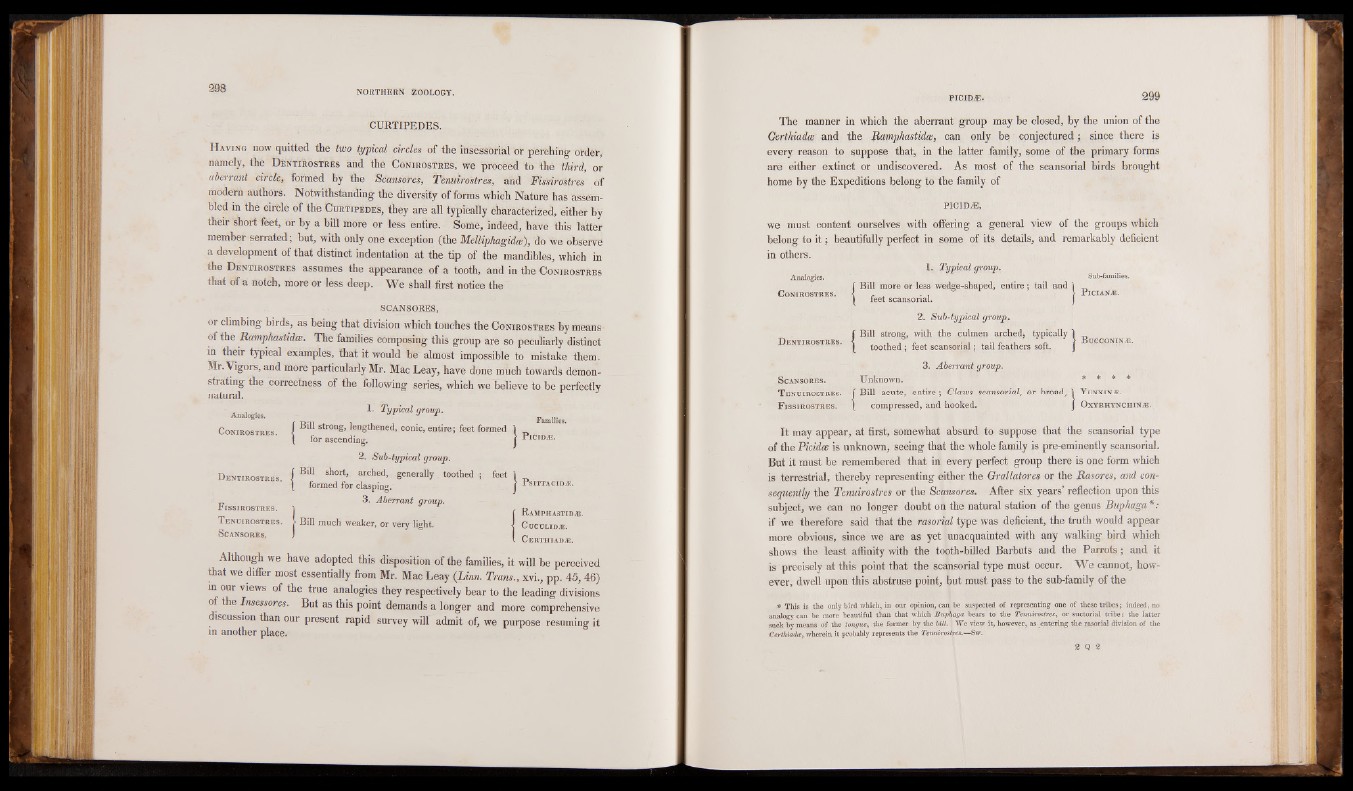
CURTIPEDES.
Having now quitted the two typical circles of thé insessorial or perching order,
namely, the Dentirostres and the Conirostres, we proceed to the third, or
aberrant circle, formed by the Scansores, Tenuirostres, and Rissirostres of
modern authors. Notwithstanding the diversity of forms which Nature has assembled
in thé circle of the Curtipedes, they are all typically characterized, either by
their short feet, or by a bill more or less entire. Some, indeed, have this latter
member serrated; but, with only one exception (the Mellipkagidw), do We observe
a development of that distinct indentation at the tip of the mandibles, which in
the Dentirostres assumes the appearance of a tooth, and in the Conirostres that of a notch, more or less deep. We shall first notice the
SCANSORES,
or climbing birds, as being that division which touches the Conirostres by means
of the Ramphastidw. The families composing this group are so peculiarly distinct
in their typical examples, that it would be almost impossible to mistake them.
Mr. Vigors, and more particularly Mr. MacLeay, have done much towards demonstrating
the correctness of the following series, which we believe natural. to be perfectly
A.na.lo.gie s. D Typical oqrorup . Families
Conirostres. I\ filflo sr taroscneSn> dlienngg.t hened, conic, entire; feet formed J| RicroiE.
2. Sub-typical group.
D entirostres. \f B‘fUo rmsehd° rfto’ r calracshpeindg> . generally toothed ;
3. Aberrant qroup. TISSIROSTR ES. "I
Tenuirostres. j- Bill much weaker, or very light.
Scansores. J
feet | PsiTTACIDvE.
{R amphastid^e.
CuCULIDAS.
Although we have adopted this disposition of the families, it wCiellr tbhei apde.r®c. eived
that we differ most essentially from Mr. Mac Leay (U rn . Trans., xvi., pp. 45, 46)
m our views of the true analogies they respectively bear to the leading divisions
of the Insessores. But as this point demands a longer and more comprehensive
idni sacnuosstihoenr tphlaance o.ur present rapid survey will admit of, we purpose resuming it
The manner in which the aberrant group may be closed, by the union of the
Certhiadce and the Ramphastidce, can only be conjectured; since there is
every reason to suppose that, in the latter family, some of the primary forms
are either extinct or undiscovered. As most of the scansorial birds brought
home by the Expeditions belong to the family of
PICIDiE,
we must content ourselves with offering a general view of the groups which
belong to it; beautifully perfect in some of its details, and remarkably deficient
in others.
Analogies.
1. Typical group.
Conirostres.
Bill more or less wedge-shaped, entire; tail and 1
feet scansorial.
Sab-families.
P lC IA N ® .
D entirostres.
2. Sub-typical group.
Bill stir ontg , -w ith the c• uil men’ .. a_r ch' ed, typ\ ic a' lly 1> Bucconin.e . toothed ; feet scansorial; tail leathers sott. J
Scansores.
T enuirostres.
F issirostres.
3. Aberrant group.
Unknown. * * * *
Bill acute, en tire; Claws scansorial, or broad, 1 Yunxinje.
compressed, and hooked. J Oxyrhynchin®.
It may appear, at first, somewhat absurd to suppose that the scansorial type
of the Picidce is unknown, seeing that the whole family is pre-eminently scansorial.
But it must be remembered that in every perfect group there is one form which
is terrestrial, thereby representing either the Gralldtores or the Rasores, and consequently
the Tenuirostres or the Scansores. After six years’ reflection upon this
subject, we can no longer doubt on the natural station of the genus Buphaga*:
if we therefore said that the rasorial type was deficient, the truth would appear
more obvious, since we are as yet unacquainted with any walking bird which
shows the least affinity with the tooth-billed Barbuts and the Parrots; and it
is precisely at this point that the scansorial type must occur. We cannot, however,
dwell upon this abstruse point, but must pass to the sub-family of the
ana*l oTghy ics ains bthe em oonrely bbeiradu twifuhli chth, ainn tohuart owphiniciohn , can be suspected of representing one of these tribes; indeed, no suck by means of the B u p h a g a bears to the T e n u ir o s tr e s , or suctorial tribe: the latter to n g u e , the former by the b i l l . , We view it, however, as ^entering the rasorial division of the
C e rth ia d c e , wherein it probably represents the T e n u ir o s tre s .—Sw.
2 Q 2